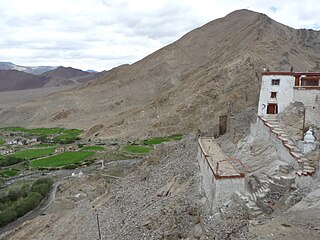
Nyoma is a principal village of southern Ladakh in India, the headquarters of an eponymous subdivision, tehsil, community development block and Indian Air Force Base in the Leh district. It is located on the bank of the Indus river after its 90-degree bend near Dungti east of Nyoma and before the valley narrows to a gorge near Mahe northwest of Nyoma. The Nyoma tehsil and subdivision cover all of southern Ladakh, including the Rupshu plains south of Nyoma, the Indus valley of Skakjung north of Nyoma, and the Hanle valley. Nyoma gompa, a Buddhist monastery, is located on the hill slope north of the village.
Kharnak is a village in the Leh district of Ladakh, India. It is located in the Nyoma tehsil.

Chumathang is a village in Leh District, Ladakh in northern India on the banks of the Indus River. Chumathang village is among the first villages in the Changthang region to have its own power station and government high school which was only possible under the guidance of Mr Gonbo. Famous for its hot spring which attracts many tourists all over the world, even the local people come every year to take the medicinal benefits from the hot spring. There is an old monastery or gonpa which is located near the road which is about more than 400 years old and is among the oldest monasteries of Ladakh.
Nyoma is a genus of longhorn beetles of the subfamily Lamiinae, containing the following species:
Ropica fuscosignata is a species of beetle in the family Cerambycidae. It was described by Breuning in 1972.
Tarchit is a village in the Leh district of the Indian union territory of Ladakh. It is located in the Nyoma tehsil.
Kungyam is a village in the Leh district in the Indian union territory of Ladakh. It is located in the rong block chumathang, which is primarily administered by Nyoma tehsil. It has more than 40 households. The local Ladakhi language is mainly used, but the people can also understand and communicate in Hindi. Sabgyat is a stupa located at the end of village, which consists of 108 stupas and it is believed to be built by Dakini. In Kungyam, there is a primary and middle school, as well as a health and wellness center.
Anlay is a village in the Leh district in the Indian union territory of Ladakh. It is located in the Nyoma tehsil.
Tukla is a village in the Leh district of Ladakh, India. It is located in the Nyoma tehsil.
Himya is a village in the Leh district in the Indian union territory of Ladakh. It is located in the Nyoma tehsil.
Teri is a village in the Leh district of Ladakh, India. It is located in the Nyoma tehsil.
Mood is a village in the Leh district of Ladakh, India. It is located in the Nyoma tehsil.
Kerey is a village in Leh district in the Indian union territory of Ladakh. It is located in the Nyoma tehsil.
Samad Rakchan is a village in the Leh district of the Indian union territory of Ladakh. It is located in the Nyoma tehsil.
Liktse is a village in Leh district of the Indian union territory of Ladakh. It is located in the Nyoma tehsil.
Mimosciadella fuscosignata is a species of beetle in the family Cerambycidae. It was described by Breuning in 1958.
Nyoma fuscomaculata is a species of beetle in the family Cerambycidae. It was described by Breuning in 1971. It is known from Mozambique and Zimbabwe.
Nyoma pusilla is a species of beetle in the family Cerambycidae. It was described by Breuning in 1943, originally under the genus Sophroniella.
Eunidia fuscosignata is a species of beetle in the family Cerambycidae. It was described by Stephan von Breuning in 1954.

